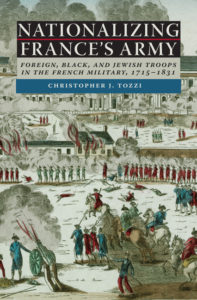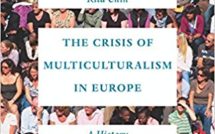
Nationalizing France’s Army: Foreign, Black and Jewish Troops in the French Military, 1715-1831 by Christopher Tozzi
 This is part of our special feature on Nationalism, Nativism, and the Revolt Against Globalization.
This is part of our special feature on Nationalism, Nativism, and the Revolt Against Globalization.
The French Revolution has long been acknowledged as a watershed in the history of France. Over the past two-and-a-quarter centuries it has spawned a plethora of studies from scholars, statesmen, political scientists, and polemical ideologues, while the wars that engulfed Europe from 1792-1815 are amongst the most written about in history. To find something new to say about the period, and to shed new light onto our existing understanding, is therefore no mean feat; nevertheless, this is what Christopher Tozzi achieves in Nationalizing France’s Army: Foreign, Black and Jewish Troops in the French Military, 1715-1831. Although the book title advertises a more chronologically expansive study, the central focus and most impressive arguments concern the key years of 1789-99. This crucial revolutionary decade saw France’s new leaders begin to reconceptualize and attempt to codify what it meant to be French, and to struggle to impose their vision onto a broad, diverse, and often reluctant national community. Tozzi presents a well-researched and valuable addition to this discussion, showing how soldiering was used to help to define the limits of French citizenship from the ancien régime to the Bourbon restoration, and demonstrating how concepts of identity were challenged by the claims of foreign, black, and Jewish soldiers to both citizenship and, ultimately, Frenchness.
The book begins with an overview of foreign units in ancien-régime France but devotes little space to in-depth analysis of this topic. Instead, the next four chapters analyse the role of “others” in the French army from the early Revolution to the Consulate, often focusing on the revolutionaries’ attempts to reconcile their nascent ideologies with the practical exigencies of warfare and military recruitment. Chapter six continues that discussion into the Napoleonic Empire, while chapter seven looks more specifically at the role of Jewish soldiers after 1789. While the book progresses largely chronologically from the ancien régime to Napoleon via the National Assembly, war, Terror, Directory, and Consulate, this is by no means a mere narrative of the development of the French army. Instead, it looks at how and why foreign, black, and Jewish men were accepted or rejected for service, using an admirable range of material to construct a picture of the development of national policy and of how these policies translated into action on the ground. The implications of these policies are discussed not only for the army, but also for France’s new national community.
The implications that Tozzi draws out are, in some ways, surprising. At a time when liberty-loving foreign civilians were being welcomed into France, and ideas of a republic of mankind (with France at its centre, naturally) were being spoken of in earnest, deputies to the newly embodied National Assembly were decrying the presence of foreign troops in French service. Tozzi’s work highlights the dichotomous nature of many of the contemporary debates on citizenship and military service in the 1790s, showing that the rhetoric of the expansive liberal nation struggled to impose itself onto ideas of who should bear arms in the nation’s defence. Universalist principles are juxtaposed with demands for a national army; contemporary confidence in the professionalism of foreign units is presented alongside denunciations of non-native troops as unreliable or even counterrevolutionary; eager foreign volunteers are shown kicking their heels petitioning to defend France, while reluctant Frenchmen are pressed to fight at the front.
The picture that Tozzi manages to tease out of his sources throws something of a questioning light onto debates around cosmopolitan universalism in the early Revolution. Tozzi does not contest that this period saw a generally more open spirit and that the distinction between Frenchmen and foreigners was in some ways blurred rather than sharpened by the events of 1789. He freely acknowledges the openness shown to foreign civilians, but he offers a compelling argument that the national turn towards a more xenophobic vision from 1793 had long been prefigured by systematic attempts from the earliest days of the Revolution to purge foreign influences from the army. Even as France welcomed Thomas Paine and Anacharsis Cloots as deputies in its Assembly, Tozzi shows how legislators were moving to disband foreign corps and to dismiss foreign regiments from French service, with admittedly mixed results. Nor were these ideologically driven policies sacrificed on the altar of military pragmatism once war broke out; as the book ably demonstrates, the dark days of 1793-94 saw the escalation of attempts to remove foreign influences from the army, despite France’s desperation for men to counter the enemy armies firmly ensconced at the Republic’s gates.
The reasons for the revolutionaries’ reluctance to employ foreign warriors receives some interrogation. The three groups discussed in this book – foreign, black, and Jewish troops – are those who Tozzi argues “fell cleanly into no category of national belonging” (8), and as such fell short of the standards of the citizen-soldier that classical republican theorists might demand. While Tozzi does not delve deeply into the origins of ideas of citizen soldiers or of a national army, he shows that these ideas were very much at the heart of early objections to foreign units being employed in the defence of a “free nation.” He also demonstrates that the widespread antipathy to foreign troops was present before it became widely believed that non-native units were more interested in defending the royal family than the realm’s frontiers, although this was clearly exacerbated by the “reductionist association between foreign troops and counterrevolution” (56) that Tozzi identifies from the earliest days of the Revolution. The claims of foreign soldiers that either military service or longstanding residency should give them the title and rights of Frenchmen were routinely denied by France’s rulers, who increasingly saw birth as the defining factor in citizenship. This largely territorial definition of the nation is somewhat at odds with more expansive definitions of citizenship, and certainly has implications for how French identity was perceived in the revolutionary period. Given the apparent centrality of birth and territory to ideas of citizenship and military worthiness, the integration of men from newly annexed territories in the later 1790s perhaps receives rather brief treatment, especially from the point of view of the annexed populations themselves. Tozzi nonetheless makes it clear that, in a military sense, annexation did not automatically make one a Frenchman, and that in fact it was increasingly through military service that some French leaders believed that annexed populations could become more French.
The overall image that Tozzi crafts of the revolutionary years is therefore largely one of mistrust and suspicion of foreign soldiers, even as many continued to serve with distinction in the French armies. This generalised picture of disdain for non-French soldiers is, however, nuanced by detailed discussion of the place and history of different national groups within the French military. From Irish exiles desperate to overthrow British rule to Dutch Patriots eager to spread revolution to the Netherlands, to Swiss guardsmen hired by the regiment from willing cantons, Tozzi covers a wide range of different experiences and motivations for foreign service. The picture that emerges is complex. If France’s rulers were content to ignore military exigencies, they were more alive to the diplomatic advantages of keeping Swiss troops before 1792, or to the political advantages of harnessing disaffected Dutch, Belgian, or Irish exiles in operations against their homelands. Tozzi also includes in his discussion several lesser-known adjuncts of the French army, such as the American Legions or the black legionnaires who served in both Europe and the Caribbean. Chapter three, which covers these early foreign legions, perhaps struggles at times to contextualise the significance of some of the units in France’s overall war effort, and might have made more of the relative willingness of Parisian powerbrokers to sponsor units depending on their geographical remoteness from the metropole, but it nonetheless offers a fascinating overview of the revolutionary experiment to take foreign troops into French service while keeping them separate from the French army.
Tozzi carries the assessment of foreign troops into the imperial years with an interesting discussion of Napoleon’s attitude to foreign soldiers. The emperor proved rather more welcoming of foreign soldiers and formed a series of corps devoted to recruiting non-Frenchmen, but as the book shows this was by no means a resurrection of ancien-régime practices. The privileges enjoyed by foreign units under the monarchy were not reintroduced during the Empire, although Napoleon did drop the French-language requirement for foreign troops. (As a second-language French speaker himself, who had also once dreamt of taking employment in the Ottoman army, Napoleon’s more cosmopolitan attitude is perhaps understandable). The chapter gives a good overview of Napoleon’s use of foreign soldiers, although the relative brevity of this section perhaps precludes full discussion of Napoleon’s conscription policies in annexed territories, or of the precise reasons for Napoleon’s disavowal of foreign troops in 1813. Tozzi nevertheless points to clear continuities from the revolutionary decade and shows that the recalibration of the relationship between soldier and citizen (or subject) that took place after 1789 was not easily undone.
The book also shows the importance of military service for setting the racial limits of citizenship. Despite the difficulty of assessing the place of black soldiers in the French army through existing records – we are told that with admirable egalitarianism the revolutionaries did not feel the need to record skin colour in official paperwork (109) – Tozzi uses the examples of primarily black units to assess how far black men could be accepted as equals in the new France. Such units are argued to have played an important “symbolic role in reinforcing the association between military service and citizenship for racial minorities” (110), but the book’s assessment of the treatment of these corps is equally valuable for the limits on citizenship that can be inferred. That some black soldiers gained a sense of equal citizenship through service is evident, but equally obvious is the low regard that many in France seemed to hold for men of different ethnicities. The fact that Napoleon felt able to transfer an entire unit of black Frenchmen in 1810 to the service of the King of Naples (admittedly at this point a Frenchman and brother-in-law of Napoleon) is rather telling. The discussion of black soldiers takes place throughout the book and black units tend to be marched in and out of chapters as required, but Tozzi’s careful cross-referencing and comparisons between Revolution and Empire ensure a coherence of both narrative and analysis.
More concentrated is the discussion of Jewish soldiers in chapter seven. Here Tozzi offers an interesting perspective on the role of the military in allowing Jews, and especially young Jewish men, to demonstrate their desire for secular French citizenship. The dynamics of exclusion faced by Jewish communities at the dawn of the Revolution were notably different from those of foreign subjects, and the treatment of this topic in a chapter of its own allows for a precise analysis to develop. The chapter demonstrates not only that many Jewish communities saw a high proportion of their menfolk serve as National Guards, volunteers or conscripts, but that many Jewish families saw this as a measure of their civic engagement and therefore of their right to be counted as French citizens. Tozzi is quick to acknowledge the diversity within the French Jewish population, but he also shows that the questions of military service and obligations to the state that arose under the Republic and Empire ultimately served to help craft a more cohesive national Jewish community.
The depth of scholarship in this work is matched by a very readable style and a high quality of presentation. One or two errors do creep in: there is repeated misuse of the rank “field marshal”(presumably a mistranslation of Maréchal de Camp), and poor Joachim Murat gets rechristened Jerôme (174), but such minor slips take nothing away from the flow of the prose or the quality of the analysis. The work is impressively referenced and contains a good bibliography, including a commentary on the archival materials that is more useful than the usual bare list of files consulted (although it might have been better placed as part of the bibliography, rather than appearing separately before the endnotes). The book is also equipped with a useful index and a pair of appendices that give a breakdown of foreign regiments and troop numbers before the Revolution.
To summarize, the contribution of this book to scholarship goes far beyond the realm of traditional military history. Tozzi has produced not only an important study of the role of foreign, black and Jewish soldiers in the revolutionary and Napoleonic armies, but also an interesting and valuable contribution to discussions on the relationship of universalism to nationalism during the fraught years of the early Revolution. It is impressively researched, intelligently presented, and makes an important fresh contribution to the study of the Revolution and Napoleonic Wars.
Reviewed by Graeme Callister, York St John University
Nationalizing France’s Army: Foreign, Black and Jewish Troops in the French Military, 1715-1831
by Christopher Tozzi
Publisher: University of Virginia Press
Hardcover / 320 pages / 2016
ISBN: 9780813938332
To read more book reviews, please click here.
Published on February 1, 2018.




